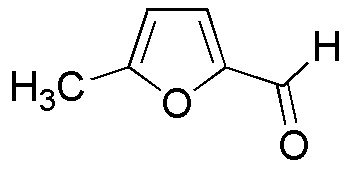5-Methylfurfural is widely utilized in research focused on various applications:
- Biofuel Production: This compound serves as a valuable intermediate in the production of biofuels, particularly in the conversion of biomass into renewable energy sources. Its high energy density makes it a promising candidate for sustainable fuel alternatives.
- Flavoring Agent: In the food industry, 5-Methylfurfural is used as a flavoring agent due to its sweet, caramel-like aroma. It enhances the sensory profile of various food products, making it popular in confectionery and baked goods.
- Solvent Applications: This chemical acts as a solvent in various industrial processes, particularly in the extraction of natural compounds. Its effectiveness in dissolving organic materials makes it useful in pharmaceuticals and cosmetics.
- Chemical Synthesis: It is a key building block in organic synthesis, facilitating the creation of more complex molecules. Researchers leverage its reactivity to develop new compounds for pharmaceuticals and agrochemicals.
- Polymer Production: 5-Methylfurfural is utilized in the synthesis of furan-based polymers, which are known for their biodegradability and potential applications in packaging materials, contributing to eco-friendly solutions in the industry.
General Information
Properties
Safety and Regulations
Applications
5-Methylfurfural is widely utilized in research focused on various applications:
- Biofuel Production: This compound serves as a valuable intermediate in the production of biofuels, particularly in the conversion of biomass into renewable energy sources. Its high energy density makes it a promising candidate for sustainable fuel alternatives.
- Flavoring Agent: In the food industry, 5-Methylfurfural is used as a flavoring agent due to its sweet, caramel-like aroma. It enhances the sensory profile of various food products, making it popular in confectionery and baked goods.
- Solvent Applications: This chemical acts as a solvent in various industrial processes, particularly in the extraction of natural compounds. Its effectiveness in dissolving organic materials makes it useful in pharmaceuticals and cosmetics.
- Chemical Synthesis: It is a key building block in organic synthesis, facilitating the creation of more complex molecules. Researchers leverage its reactivity to develop new compounds for pharmaceuticals and agrochemicals.
- Polymer Production: 5-Methylfurfural is utilized in the synthesis of furan-based polymers, which are known for their biodegradability and potential applications in packaging materials, contributing to eco-friendly solutions in the industry.
Documents
Safety Data Sheets (SDS)
The SDS provides comprehensive safety information on handling, storage, and disposal of the product.
Product Specification (PS)
The PS provides a comprehensive breakdown of the product’s properties, including chemical composition, physical state, purity, and storage requirements. It also details acceptable quality ranges and the product's intended applications.
Certificates of Analysis (COA)
Search for Certificates of Analysis (COA) by entering the products Lot Number. Lot and Batch Numbers can be found on a product’s label following the words ‘Lot’ or ‘Batch’.
*Catalog Number
*Lot Number
Certificates Of Origin (COO)
This COO confirms the country where the product was manufactured, and also details the materials and components used in it and whether it is derived from natural, synthetic, or other specific sources. This certificate may be required for customs, trade, and regulatory compliance.
*Catalog Number
*Lot Number
Safety Data Sheets (SDS)
The SDS provides comprehensive safety information on handling, storage, and disposal of the product.
DownloadProduct Specification (PS)
The PS provides a comprehensive breakdown of the product’s properties, including chemical composition, physical state, purity, and storage requirements. It also details acceptable quality ranges and the product's intended applications.
DownloadCertificates of Analysis (COA)
Search for Certificates of Analysis (COA) by entering the products Lot Number. Lot and Batch Numbers can be found on a product’s label following the words ‘Lot’ or ‘Batch’.
*Catalog Number
*Lot Number
Certificates Of Origin (COO)
This COO confirms the country where the product was manufactured, and also details the materials and components used in it and whether it is derived from natural, synthetic, or other specific sources. This certificate may be required for customs, trade, and regulatory compliance.


